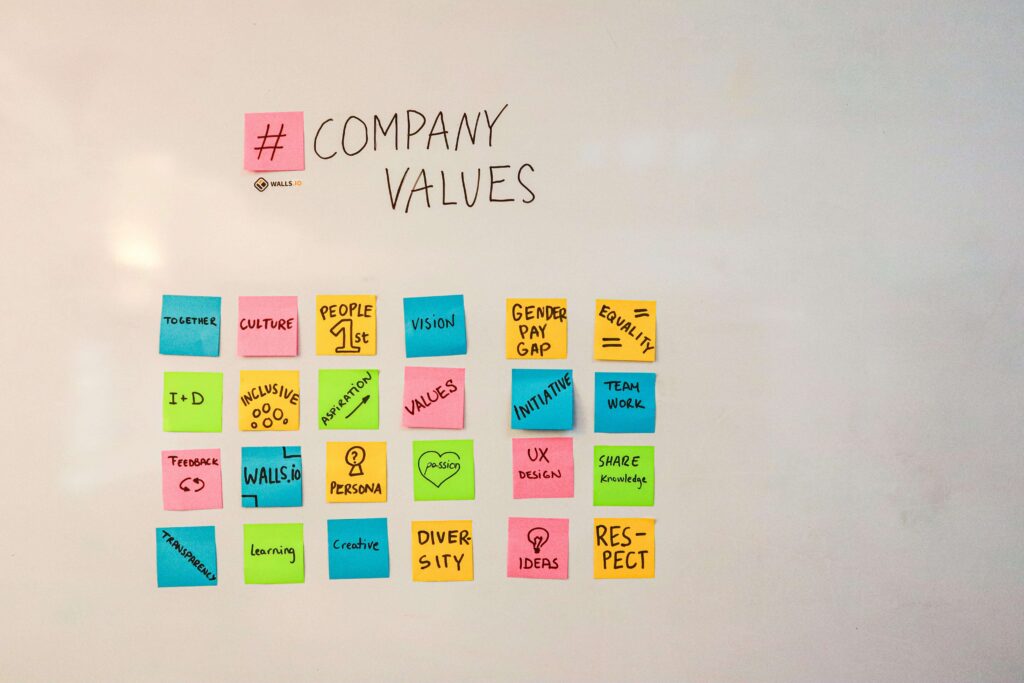Why is diversity management important?
The targeted promotion of diversity brings numerous benefits, including:
- Innovation and creativity:
Different perspectives lead to new ideas and approaches. - Expanding the talent pool:
Diversity opens doors to a wider range of professionals. - Greater customer focus:
Teams that reflect the diversity of their customers better understand their needs. - Better decision making:
Studies show that diverse teams make more informed decisions. - Positive company culture:
An inclusive work environment increases employee satisfaction and loyalty.
Strategies in diversity management
Method 1: Define clear goals and guidelines
Diversity management requires a clear focus.

Companies should develop a diversity strategy that is reflected in their vision, mission and values.
It is important to set concrete and measurable goals, such as increasing the proportion of women in management positions or the integration of people with disabilities.
2nd method: training and awareness-raising
Unconscious prejudices are often obstacles to genuine diversity.
Regular training courses help employees to recognize and overcome these prejudices.
Workshops on intercultural competence, inclusion and equality promote better understanding and open communication.
3rd method: Inclusive recruitment
The recruitment process should be designed in such a way that it breaks down unconscious barriers.
This includes:
- Anonymous application procedures to avoid discrimination.
- Use of gender-neutral language in job advertisements.
- Actively addressing underrepresented groups via specialized platforms.
4th method: Mentoring and support programs
Targeted programs can help underrepresented groups to advance professionally.
For example, mentoring programs can give women or employees with a migration background access to networks and career opportunities.
5th method: Flexible working models
The introduction of flexible working time models, home office options or part-time work helps to better accommodate different lifestyles and needs.
Parents, people with disabilities and older employees in particular benefit from such offers.

6th method: Support networks for employees
Enable the creation and promotion of internal networks, e.g. for women, LGBT+ or people with disabilities.
Such networks offer opportunities for exchange, strengthen the community and promote an inclusive corporate culture.
7th method: Involve managers
Managers play a key role in diversity management.
They should act as role models who actively support diversity.
This includes participating in training, promoting diverse teams and highlighting career opportunities for all.
8th method: Continuous review and adaptation
Diversity management is a dynamic process.
Companies should regularly review how effective their measures are and make adjustments where necessary.
Tools such as diversity audits or employee surveys offer valuable insights.
9th method: communication and transparency
Successes in diversity management should be made visible.
This not only strengthens internal acceptance, but also shows externally that the company takes diversity seriously.
Reports, campaigns and events can have a major impact here.
Challenges and how to overcome them
1st challenge: Resistance within the company
Employees may fear that new measures will change their day-to-day work or call existing structures into question.
Open communication and transparency are key to overcoming this resistance.

Managers should provide information about the goals and benefits of diversity management at an early stage and encourage an open dialog.
Best practices and success stories that show the positive impact diversity has on the company and cooperation are particularly helpful.
In addition, it can be useful to offer training courses and workshops to break down prejudices and create a better understanding of the importance of diversity.
When employees realize that diversity is not just an abstract concept, but a real added value for the corporate culture and success, acceptance grows.
2nd challenge: Unconscious bias
Unconscious bias influences decisions in companies, often unnoticed.
Anti-bias training, standardized processes in personnel selection and diverse teams help to minimize them.
Mentoring programs promote equal opportunities, while open communication and a feedback culture ensure greater awareness in the long term.
Diversity is a continuous process – targeted measures create a fair and inclusive corporate culture.
Challenge 3: Measuring success
Diversity and inclusion are often difficult to quantify, but without measurable data, their success remains unclear.
Companies should therefore define clear KPIs (Key Performance Indicators) to make progress visible.

Possible KPIs for diversity & inclusion:
- Gender distribution & diversity ratio:
Proportion of diverse groups in teams and management levels. - Employee satisfaction & retention:
Regular surveys to capture whether all employees feel valued and included. - Promotion and recruitment rates:
Transparency on career opportunities for diverse talent. - Turnover rates:
Analyze whether certain groups are leaving the company more frequently. - Participation in D&I initiatives:
Number and impact of training courses, workshops and networks.
Qualitative data, such as feedback interviews or focus groups, also help to better understand the corporate culture.
Conclusion
Diversity management is not only a moral and social imperative, but also a strategic success factor.
Through targeted strategies such as inclusive recruitment, training, flexible working models and the promotion of an open corporate culture, companies can make the most of the benefits of diversity.
The key is not just to tolerate diversity, but to actively promote it and integrate it into the corporate culture.
In this way, companies not only create a better working environment, but also secure a long-term competitive advantage in a globalized and diverse world.




